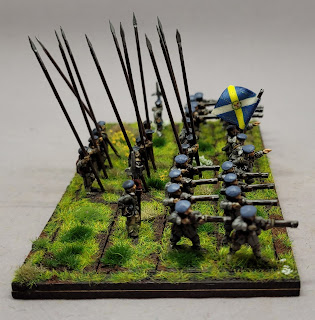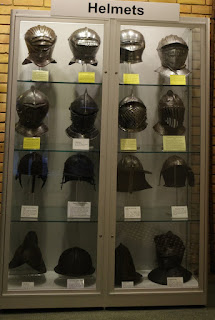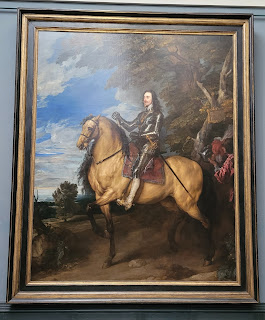The firstly overtly Welsh post for the now inappropriately named ECWtravelogue sees a venture across the Welsh Marches into Powys.
The main focus of this entry in Montgomery and its battlefield. And to the man who was wandering into the castle saying to his family "I think there's a load of Civil War stuff here, I looked on KeepYourPowderDry but there wasn't anything" - here it is!
 |
| Good views of the battlefield, and an information panel can be found in the castle's outer ward |
Montgomery Castle was originally a motte and bailey castle built in the mid-eleventh century, being replaced by a stone castle in the thirteenth century. Having walked, or more sensibly driven up to the castle, you'll understand exactly why the castle was built where it was.
 |
| The walkway crossing the ditch into Montgomery Castle's inner ward |
Fast forward to the Civil Wars: most of Wales supported the Crown. Montgomery Castle was garrisoned by Royalists, under the command of the elderly Lord Herbert of Cherbury.
In September 1644, he surrendered the Castle to Parliamentarian troops commanded by Sir Thomas Myddelton and Thomas Mytton.
It was this, Parliamentarian, garrison that precipitated the battle of the 18th September 1644.
Lord Byron was attempting to create a strong North Wales/Cheshire field army in 1643 for the King, which could control the corridor connecting Chester to Oxford and Bristol. Unfortunately a loss at Nantwich in January 1644 set his plans back considerably.
Early in September, Colonels Myddelton and Mytton advanced from Oswestry into the upper Severn Valley and captured Newtown by surprise. In Newtown, they captured a convoy of gunpowder which the besieged Royalists at Liverpool desperately needed. They then advanced to Montgomery. The medieval defences of the town were in ruins but the castle was largely intact. However, its governor, Lord Herbert, was ill and apparently unwilling to play any part in the war. He surrendered the castle on terms on the 5th September.
Three days later, a Royalist force commanded by Sir Michael Erneley and Sir William Vaughan advanced from Shrewsbury, taking the Parliamentarians by surprise. The new garrison were out acquiring supplies. Mytton's men retreated into the castle with 500 infantry, while Myddelton rode away with the cavalry to seek help. The Royalists began to dig trenches and construct earthworks around the castle, preparing for a formal siege.
The Royalist besiegers were bolstered by fresh men under Lord Byron, and possibly some of the Northern Horse (who had escaped from Marston Moor): the besieging force now consisted of 2,800 infantry, 1,400 cavalry and 300 dragoons.
Myddelton had not been idle, rustling up men from Brereton's forces, and Sir William Fairfax brought men over from Yorkshire; the Parliamentarian relief column was commanded by Sir John Meldrum and numbered 2,000 infantry and 1,500 cavalry. Not forgetting 500 men holed up inside the castle.
The battle is relatively poorly documented, but it is believed that Byron left some men protecting his rear from the castle, whilst the main body of his men turned north to face the advancing Parliamentarian relief column. The two sides facing one another on the 17th September, but without any significant contact. During the next day a number of Parliamentarian cavalry left their positions to forage for supplies. This was all Byron needed to start proceedings.
The Parliamentarian lines were north of the River Camlad, with Offa's Dyke protecting their eastern flank.
Byron's initial attack was to secure the Salt Bridge, but initial Royalist gains were quickly overturned and the Royalists were routed. Reports of Royalist casualties were 500 men killed and 1,500 taken prisoner.
What's there today?
Newtown, to the south west of Montgomery, bears no evidence of the gunpowder incident. The barely evident remains of an old motte were fortified and briefly occupied by Sir John Price for Parliament in 1641. This mound can just about be seen in The Park close to the corner of Park Street and Frolic Street.
 |
| Montgomery Castle |
Montgomery Castle was sleighted by order Parliament in June 1649, after Wales rose in support of the Crown during the Second Civil War. The ruins are cared for by CADW, and are free to visit.
 |
| Montgomery Castle |
To the west north west of the castle is an iron age hill fort, which is where it is thought that Byron kept his rearguard (stopping Mytton's men leaving the castle and joining the fray). Best viewed from the remains of the castle, or a circular walk from the castle grounds takes the position in. Parking for the castle can be found at Arthur Street. For those of you who choose to park in the town and walk up to the castle the signpost close to The Dragon hotel is not exaggerating when it states 'steep'.
 |
| The hill fort WNW of Montgomery Castle, likely location of the Royalist rearguard |
In the town itself the town walls were dilapidated at the time of the siege, but some remnants still remain.
 |
| St Nicholas's Church |
St Nicholas's Church was built at the same time as the castle was converted into a stone castle. Colonel Richard Herbert, (Sir Henry's son) is buried inside the church. Sir Richard was MP for Montgomeryshire prior to the outbreak of war, and commanded a Royalist regiment of foot, and a troop of horse. At various points he was governor of Ludlow (1643), Aberystwyth (1644) and Newport (1645). Sir Richard does not have his own tomb, or memorial plaque. He is buried in the family vault which has a rather impressive memorial to his grandfather atop.
 |
| The Herbert Memorial |
 |
| The Old Bell Museum and one of Montgomery's buildings that witnessed the battle |
The Old Bell Museum has many artefacts from the battle on display; only open during the spring and summer months, please check their website before visiting.
The modern Salt Bridge may exist upon the same location as the C17th Salt Bridge, but we do not know for certain. This modern structure is a blink and you'll miss it affair.
Excellent views of the battlefield, and an information panel can be found on Offa's Dyke, accessible from the Hem road (sign posted Marton eastwards off the B4388), north of Montgomery. There is parking for one car, a hundred metres or so past where the Offa's Dyke path crosses the road (going towards Hem). The information board is 150 metres or so up the (steep) hill, on the north side of the road.
 |
| Powis Castle |
Powis Castle, was a Royalist stronghold. Taken by a force led by Sir Thomas Myddleton in October 1644; a petard blew apart the gatehouse affording entry to the castle.
Now cared for by the National Trust. Powis has a very impressive collection of C17th tapestries, and as an understandable consequence, lighting throughout the castle is subdued and there is a strict no photography rule. The long gallery has a number of portraits of the extended Herbert family who fought during the Wars.

|
If you take advantage of the castle's café, beware the peacocks - they'll try to steal your cake and sandwiches
|
Postcodes for SatNavs and mapping apps
Newtown Motte, Park Street, Newtown SY16 1EF
Montgomery Castle, Pool Rd, Montgomery SY15 6QYCastle parking, Arthur Street, Montgomery SY15 6RA
Town Walls, Arthurs Gate, Montgomery SY15 6QU
The Old Bell Museum, Arthur St, Montgomery SY15 6RA
St Nicholas's Church, Lions Bank, Montgomery SY15 6PT
Battlefield Information board, Hem road, SY21 8NU, location of the information board SJ 229 000Powis Castle,Welshpool SY21 8RF
If you enjoyed reading this, or any of the other posts, please consider supporting the blog. Thanks.























Wonderful pictures as usual. We have played Montgomery a couple of times with 2 different rule sets; in both cases the Royalist commander faired worse than Byron.
ReplyDeleteThanks Codsticker. Such a good battlefield to visit, really good vantage points to view the whole battlefield.
Delete